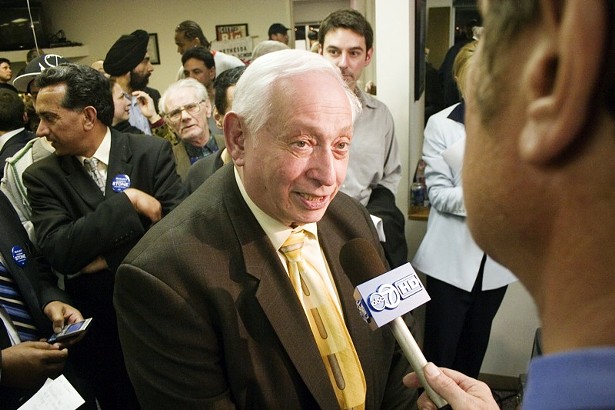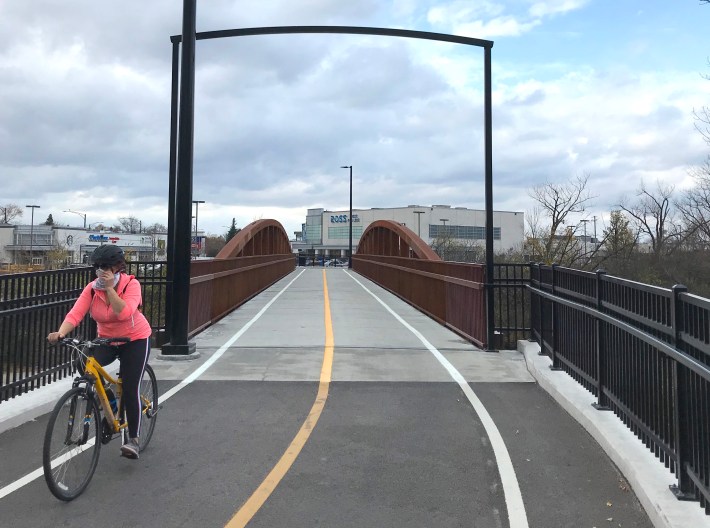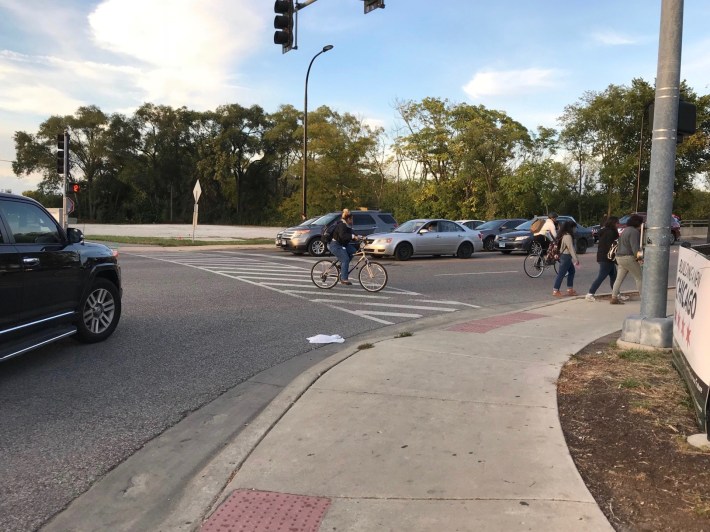Today we can finally close the book on the long saga of the Lincoln Village Pedestrian Bicycle Bridge, aka the Stone Free Bridge. 15 years after the late 50th Ward alderman vetoed the construction of the already-designed and funded span under mysterious circumstances, the city of Chicago finally did an official ribbon-cutting for the $3.4 million overpass, the final missing link in the North Shore Channel Trail.
The 16-foot-wide, 180-foot-long span enables residents to travel the entire Chicago portion of the path, which runs nearly seven miles from Albany Park to Evanston, without making any major street crossings. Most of the trail's section within the city hugs the east bank of the channel, but north of Lincoln Avenue the path shifts to the west bank. The opening of the bridge means that people strolling, running, and biking are no longer forced to make the crossing via Lincoln, a busy four-lane highway.
By 2005, the Chicago Department of Transportation had designed a bridge near this location and secured funding for it. Stone -- who ruled the Far-North West Ridge neighborhood from 1973 until being beaten by current alderman Debra Silverstein in a runoff in 2011 -- originally endorsed the project. But he pulled his support after funding was secured, forcing the department to put the initiative on ice. (I was working as CDOT’s bike parking program manager at the time but wasn’t involved in bikeways planning.)

Stone gave various dubious explanations for his opposition to the bridge. But former Active Transportation Alliance executive director Rob Sadowsky, told me that there was a racial element to Stone’s bridge opposition. Sadowsky said that at a community meeting he attended in 2001, Stone referred to African-American and Latino youths as “little blacks and browns.” The alderman implied, according to Sadowsky, that the ward should avoid measures that would bring more young people of color to the neighborhood. Stone’s children have vehemently denied the claim that Stone was racist.
Stone died in 2014, so we may never know the truth about his motivations. The important thing is that, while he’s gone, the bridge is here, unofficially opening last December, and it’s a nice-looking facility that's making walking and biking safer and more pleasant in his former fiefdom. Since the official opening event was delayed by the COVID-19 pandemic, Streetsblog Chicago held our own guerrilla ribbon-cutting for Stone Free Bridge in May, including a performance of the Jimi Hendrix song "Stone Free."
Due to the pandemic @ChicagoDOT was unable to hold an official ribbon-cutting for the new Lincoln Village Bridge, aka the Bridge That Alderman Berny Stone Blocked, aka the Stone-Free Bridge. So we held an unofficial one.@50thWardChicago @ChiCritMass #bikeCHI #JimiHendrix pic.twitter.com/R4BZo0zPHM
— Streetsblog Chicago (@streetsblogchi) May 23, 2020
At today's ceremony, Alderman Silverstein celebrated the bridge as "a great thing for the safety of our bicyclists and pedestrians."
CDOT chief Gia Biagi called the span, which was fabricated in pieces in Minnesota and assembled on the riverbank, "a really critical asset for the entire North Shore Channel corridor." She added, "More than ever we need places to be outside together, but have distance."
"Too long this was a perilous crossing," said Active Transportation Alliance advocacy manager Julia Gerasimenko, who lives nearby. "Now I'm taking walks here every evening. Being able to cross the trail gap is just thrilling."

On her first day in office, Mayor Lori Lightfoot signed an executive order that supposedly ended Chicago’s de-facto policy of aldermanic prerogative, the power of aldermen to veto projects within their wards, but in reality, this entrenched tradition has been a difficult nut to crack.
I asked Biagi whether anything had changed over the last decade and a half to keep aldermen from blocking good projects like a bike bridge for no obvious reasons. "This project is emblematic of listening to aldermen, what they're hearing from their communities, what they're bringing to the table, and what we identify as needs," she replied. "And when it all snaps together you get a bridge like this. So I think we're in a mode of working on how we are cooperating together and listening to each other, and looking at where there are opportunities, and that's the way forward."
Silverstein said she never heard what Stone's real motivations were for blocking the bridge. Asked if there were any lessons from this story, the alderman responded, "Again, I can't speak for [Stone], but I do know that many community members asked for the bridge, and it has definitely improved safety, so I'm just really happy that I was able to bring it here for my constituents and everyone to use."
Asked what ATA can do to help stop aldermanic veto fiascos like this in the future, Gerasimenko replied, "We continue to elevate community voices. So when you have a critical mass of constituents saying, 'This is what we need, this is what we want,' from communities up and down the trail, that's how we build people power and make our voices heard, and hopefully our elected officials will carry that message forward. So that's the most we can do, just keep organizing people."

Speaking of organizing people, the next steps for improving safety along the North Shore Channel Trail would be addressing its many dangerous street crossings north of the city. In September 2018, an underage driver fatally struck contractor Jesse J. Rodriguez, 67, on his bike at the path crossing at Devon Avenue and McCormick Boulevard, two blocks north of the bridge. And many of the suburban street crossings take place at intersections with wide turning radii, where trail users are forced to keep and eye out for swiftly turning drivers when they have a Walk signal. It would be great to see ATA lobby for safety improvements, such as creating a dedicated pedestrian signal phase at these junctions.





